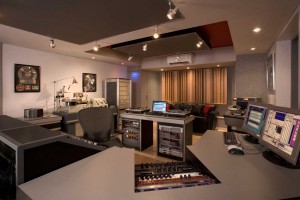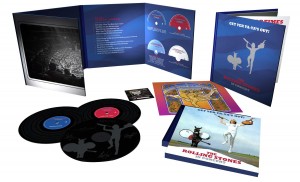Day Trips: Trutone Mastering Hones the Rolling Stones A Little North of NYC
ORANGEBURG, NY: If New York City were a nonstop metropolis – just city blocks stretching out to eternity – our beloved Gotham could get a little old. But the existence of amenities like grass, trees, fresh air and quietude within driving distance is good to know about, just in case.
Trutone Mastering gives NYC artists an excuse to spend a productive day in more natural surroundings, with their world-class mastering destination located a little north of the city in Orangeburg, NY. There, the Walters-Storyk Design Group virtually replicated Carl Rowatti’s suite from Trutone’s previous address on 54th Street and 8th Avenue in NYC.

Trutone HQ
Trutone’s owners — Carl and Adrianna Rowatti – elected to build their 1500 sq. ft. digital/analog mastering facility into their home after Sony BMG acquired their aforementioned midtown complex. Today, the fully floating room accommodates highlights like a brass- face Fairchild 670 compressor, while vinyl aficionados will take notice of a Neumann SP-77 mastering console, and Neumann lathe with SAL-74B cutting rack/SX-74 cutter.
In addition to prestigious vintage gear, the studios is also equipped with the considerable experience of Carl Rowatti, whose credits include Bruce Springsteen, Bob Dylan, Yung Joc, Cassie, Whitney Houston, Pavarotti, The Killers and the Rolling Stones. “Mastering has always been important,” he notes, “but now it’s becoming increasingly critical as so many mixes are produced in far-less-than-ideal conditions.
“Moving the studio up here has been great. We regularly pick clients up at the bus stop, or if they drive up they love the fact that they can preview their mastered tracks on their car’s sound system. At the midtown location, a client would have to go down 10 flights in the elevator and find their car in the parking garage to accomplish this. So it’s worked out very nicely for all the attended sessions.”
Recent projects for Trutone have included digital or vinyl projects for Elliot Smith, Taylor Bright, Grant Hart, The Gentle Giant and Nicole Martin. But a definite highlight had to be 2009’s assignment to master the special vinyl edition of Get Yer Ya-Ya’s Out!, a 40th Anniversary re-release of The Rolling Stones’ landmark Madison Square Garden live album. Issued by ABKCO Records, the special package included not only the original 1970 album and unreleased material from the Rolling Stones, but previously unreleased sets from B.B. King, and Ike & Tina Turner.
For Rowatti and ABKCO Chief Engineer/Archivist Teri Landi, handling GYYO required kid gloves, and then some. “We spent extra studio time working on maximizing the levels for the records, because the sides were pretty long at 25:40 seconds, or 22:13 – 18:00 to 20:00 minutes is the typical length for a side,” Rowatti says. “A vinyl record is a mechanical storage medium with a fixed amount of space. During the cutting process, grooves are etched into the surface of the disc and are spaced to fill the surface of the record. When the program is short the grooves are spaced further apart, for longer programs they are spaced closer together.

Get Yer Ya-Ya's Out!
“In simple terms, grooves modulate in direct correlation to the sound being etched into them. Certain factors determine how large an excursion the groove will make – recorded volume and the frequency of the sound being recorded. Bass causes the record groove to make large excursions, left to right. As frequencies rise, the excursions lessen, so it is the bass or low frequency content (in conjunction with the recorded volume) that uses up the most space on the surface of the record. The goal is to cut a long side with maximum level and minimal audible alteration — to accomplish this, in many instances, a high pass filter is employed to filter subsonic material that causes the widest excursions. On occasion, if the bass is excessive, a slight low frequency roll off can be utilized. While each step is not drastic, the effect is cumulative.
“Additionally, a degree of vertical compression can be applied. We achieve this by utilizing our vintage Fairchild 670, which controls out-of-phase low frequency information that causes the groove to cut very deep, then very shallow. Once again, this alteration maximizes level and makes the disc easier to mold once it reaches the pressing plant.”
To achieve maximum level on the Stones project, Rowatti carefully optimized the cutting process in order to accommodate the uncommon length of GYYO. “You have a fixed amount of space you can work on the surface of the record,” he observes. “Modulation (music) can start at a diameter of 11 ½” on the outside of the record and end no closer than 4 ¾” approaching the label area without allowing the grooves to overcut one another, which will cause a skip. You have to juggle between the recording pitch, the level you’re cutting and then the alterations primarily in the low end.”
For Landi – who has been part of landmark remastering and archiving projects for ABKCO since joining the label in 1989 – the jaunt to Orangeburg proved worthwhile in maximizing the new master lacquers for Get Your Ya-Ya’s Out. “With long sides, at the end it may lose high end,” she says. “Carl was able to manage that very well. We did several test cuts so we could preview the sound as we got closer to the inner groove – it was really great to do that kind of experimentation with him.
“I like to go to sites like Amazon and see what the fans are saying. When I look at reviews for the box set, people are very impressed with it. That says to me that there are people who are listening and hearing the difference. That’s a good thing.” – David Weiss






